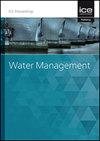河流构造的活河床冲刷对河床迁移的响应
IF 0.9
4区 工程技术
Q3 ENGINEERING, CIVIL
Proceedings of the Institution of Civil Engineers-Water Management
Pub Date : 2023-05-22
DOI:10.1680/jwama.22.00057
引用次数: 0
摘要
冲积河流的迁移河床会加剧冲刷对河流结构的破坏,导致严重的结构破坏,从而导致大规模和长期的河流形态和环境问题。本研究基于水槽实验的大数据集,研究了河流结构冲刷波动与河床迁移之间的相互作用。考虑了典型的二维(沉堰)和三维(均匀和复杂的桥墩)结构。实时活床冲刷深度由两个分量构成:由河床形态引起的动态冲刷放大量为;无河床形态的局部流致基线冲刷深度dsNB(即为NB)。ds为最大活层冲刷深度平均值与dsNB的相减。结果表明,对于二维结构,基线冲刷深度可以忽略不计(dsNB→0),而活床冲刷主要是由接近的床型引起的。随上游角度的不同,动态冲刷放大的归一化程度在0.5 ~ 2之间。具体而言,随着上游的增加;对于均匀的3-D结构,局部流动可引起相当大的基线冲刷深度,并且随着流动能力的增加而降低,使接近的河床变形和受潮。对于复杂的3-D结构(例如复杂桥墩),结构部件(例如桩承台)下方的流动压力可以放大到接近1的程度。总结实验数据发现,ds_NB/y0与ds_NB/ Hb呈负相关,其中y0为流动深度。最后,提出了估算各种水流结构动力冲刷放大的新方程,并推荐了设计准则。本研究首次从非静态角度对多流结构的时敏冲刷放大进行了理解。本文章由计算机程序翻译,如有差异,请以英文原文为准。
Responses of live-bed scour at instream structures to fluvial bedform migration
Migrating bedforms in alluvial rivers can exacerbate scour damage instream structures, leading to severe structure failures, which can cause large-scale and long-term issues with fluvial morphology and environment. This study investigates the interaction between scour fluctuation at instream structures and bedform migration based on large datasets from flume experiments. Both typical 2-D (submerged weirs) and 3-D (uniform and complex piers) structures are considered. Two components constitute real-time live-bed scour depth: the dynamic scour amplification ▵ds caused by bedforms, and the local flow-induced baseline scour depth dsNB without bedform (i.e. denoted as NB). ▵ds is the subtraction of mean of maximum live-bed scour depths and dsNB. Results show that, for 2-D structures, the baseline scour depth is negligible (dsNB→0), while the live-bed scour is mainly caused by the approaching bedform. The dynamic scour amplification normalized by the approaching bedform height (▵ds/Hb) varies between 0.5∼2 depending on the upstream angle. Specifically, ▵ds/Hb decreases with the increase of upstream. For uniform 3-D structures, the local flow could cause a considerable baseline scour depth, and ▵ds/Hb varies between 0.25∼0.5 and decreases with an increase in the flow capacity to deform and damp the approaching bedforms. For complex 3-D structures (e.g. complex piers), the flow pressurisation beneath the structural components (e.g. pile-caps) could magnify ▵ds/Hb to near 1. Summarising experimental data shows that ▵ds/Hb is inversely correlated with ds_NB/y0, where y0 is flow depth. Finally, new equations are proposed for estimating the dynamic scour amplification at various instream structures with design rules recommended. This study, by the first time, enables the understanding of the time-sensitive scour amplification at multiple instream structures from a non-static perspective.
求助全文
通过发布文献求助,成功后即可免费获取论文全文。
去求助
来源期刊
CiteScore
2.10
自引率
0.00%
发文量
28
审稿时长
6-12 weeks
期刊介绍:
Water Management publishes papers on all aspects of water treatment, water supply, river, wetland and catchment management, inland waterways and urban regeneration.
Topics covered: applied fluid dynamics and water (including supply, treatment and sewerage) and river engineering; together with the increasingly important fields of wetland and catchment management, groundwater and contaminated land, waterfront development and urban regeneration. The scope also covers hydroinformatics tools, risk and uncertainty methods, as well as environmental, social and economic issues relating to sustainable development.

 求助内容:
求助内容: 应助结果提醒方式:
应助结果提醒方式:


